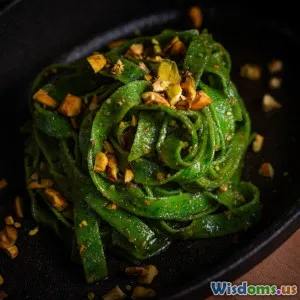
Why Meatless Burgers Win Blind Taste Tests
14 min read Explore why meatless burgers often outperform beef in blind taste tests, examining flavors, textures, and consumer perceptions. (0 Reviews)
Why Meatless Burgers Win Blind Taste Tests
Ordering a burger today isn’t as straightforward as it used to be. In restaurants and grocery aisles, meatless patties often sit right beside their traditional beefy cousins. Remarkably, when all wrappings and labels are removed, taste testers frequently find themselves favoring the plant-based alternative—even when they believe only genuine beef can satisfy their craving. What’s behind this surprising trend? Let’s take a bite into why meatless burgers often come out on top in blind taste tests, and what this signifies for our palates and the future of food.
The Science Behind Flavor Perception

The complex experience we call “flavor” isn’t just about taste—it’s a symphony of aroma, texture, appearance, and memories. Modern meatless burger innovators, like Impossible Foods and Beyond Meat, leveraged the science of flavor perception to craft patties nearly indistinguishable from beef.
Researchers discovered that molecules such as heme (an iron-containing compound) play a crucial role in meat's characteristic flavor. The Impossible Burger famously extracts heme from soy plants, recreating the distinctive metallic, umami-rich profile of real beef. Other brands blend pea protein, mushroom extracts, coconut oil, and a spice medley to precisely mimic the juicy mouthfeel and savory notes long associated with burgers.
Example: In a 2019 Journal of Food Science study, consumers could not consistently identify the beef burger when pitted against high-quality plant-based competitors, revealing how successfully these companies have hacked the elusive fifth taste, umami.
Texture: Why the "Bite" Matters

Real burger aficionados know that bite and chewiness are half the experience. Early veggie burgers fell flat in this domain, revealing their plant origins with every mushy mouthful. But recent advances have upended these expectations.
Through high-moisture extrusion (a food processing technology), modern manufacturers align plant proteins to create a fibrous texture. This structural tweak gives meatless patties a realistic snap, resistance, and juiciness that rivals premium chuck.
Case in Point: At the 2022 "Great American Blind Burger Taste-Off," conducted by Cooks Illustrated, a quarter of meat-loving testers mistakenly chose a Beyond Burger as beef, citing its convincing charred crust and the satisfying splay of juices upon biting.
Why It Matters: Texture isn’t just preference—it’s forged by evolutionary cues signaling quality protein. When plant-based burgers nail this element, even die-hard carnivores are easily misled.
The Role of Culinary Technique: Cooked to Perfection

How any burger is handled on the grill is make-or-break in both flavor development and texture. Meatless patties engineered to withstand searing temperatures and even “bleed” when pressed, bridge the psychological gap for tasters.
Culinary professionals use classic techniques—like smashing for a caramelized crust, or resting the patty under a cheese blanket—to make even skeptical test subjects swoon. The fatty sizzle of coconut oil and canola flow, engineered to mimic beef’s fat rendering, create the all-important aroma of a backyard barbecue.
Culinary Tip: Blind taste test kitchens often add onions, pickles, and sauce with the burger. These toppings, paired with a high-performing meatless patty, mean subtle differences are indistinguishable to most. Remarkably, when properly cooked, very few testers can reliably distinguish a plant-based burger from the real deal.
Overcoming Preconceptions: The Psychology of Taste Tests

Our brains crave familiarity, yet in the anonymity of a blind test, bias crumbles. Decades of psychology research show that expectations shape perceived taste.
Labeling a burger as plant-based—or recalling a lackluster tofu patty from years past—conditions us to expect less flavor, less satisfaction. But when volunteers are blindfolded or presented with unmarked samples, many report unusually positive experiences.
Notable Study: In a 2023 double-blind test published in Appetite, 64% of meat-eating participants stated a preference for "sample B," later revealed as a leading pea-protein burger. Researchers attribute this trend to the neutralization of brand and ingredient biases.
Key Insight: When context and marketing vanish, the intrinsic qualities of the patty—taste, savoriness, juiciness—truly matter. Meatless brands, driven to impress, often outshine traditional beef by optimizing for taste benchmarks meat enjoys by default.
Ingredient Innovation: Unlocking Crave-Worthy Umami

Great burgers are an umami bomb—rich, savory, and deeply satisfying. Plant-based engineers treat this like a culinary chemistry challenge. Where classic black bean patties relied on beans and grains, latest-generation burgers get their savor from finely-tuned sources.
The Magic of Heme: Impossible Foods pioneered the extraction of plant-based heme, ensuring the iron-rich taste and even the reddish "bleed" that comes with biting into real beef.
Natural Flavors and Additions: Makers blend mushrooms, seaweed extracts, yeast, and fermented ingredients to amp up brothiness. Some brands leverage nutritional yeast, tomato paste, smoked paprika, and caramel coloring to deepen flavor and eye appeal.
Example: The Beyond Burger balances pea protein with beet juice exemplifying how food science can delight skeptics—producing that signature "rare center" look.
This ingredient-driven focus means each bite is intentionally layered—one reason why, in controlled taste tests, burger fans frequently declare plant-based options as" more flavorful" and “cleaner tasting.”
Meatless vs. Meat: Analyzing Blind Taste Test Results

Repeated, well-controlled taste test trials have illuminated a striking reality: many consumers can’t reliably tell beef from plant-based analogues—or actually pfavor the latter.
Landmark Comparative Results:
- The Guardian’s notorious UK-wide Burger Challenge (2021): Among 120 participants, 53% preferred the vegan burger in head-to-head tastings.
- Burger King’s 2019 “Imposter Whopper Challenge” saw 44% of testers rate the Impossible Whopper higher than the standard Whopper. Anecdotally, customers were reluctant to believe the switch.
- Consumer Reports (2022) scored three leading meatless burgers within a single point of their beef comparator, noting better performance on "overall flavor balance, juiciness, and seasoning."
When testers can’t see the ingredients, qualities like savoriness, juiciness, char, and bun integration—rather than nutrition or ideology—become decisive. Meatless brands, finely attuned by focus groups to nail these elements, tend to score big.
Health, Sustainability, and the Modern Burger Movement

Tasters aren’t just swayed by their mouths—environmental and health data also color the modern burger dialogue. While blind taste testers aren’t evaluating climate impact in the moment, the broader trend owes much to the intersection of pleasure and conscience.
Environmental Impact: According to a 2020 University of Michigan report, producing a Beyond Burger results in 90% fewer greenhouse gas emissions and requires 46% less energy, 99% less water, and 93% less land compared to an American beef burger. That’s a seismic difference for eco-aware diners.
Health Profiles: Meatless burgers are generally lower in saturated fat and cholesterol, while offering comparable protein levels. Some brands now fortify with vitamin B12 and iron, mimicking the nutritional edge of beef.
Consumer Example: As seen with brands like Neat Burger (co-founded by Lewis Hamilton) and the growing “flexitarian” movement, people eager for sustainability now demand a burger that ticks every box—taste tested flavor and eco-friendliness.
Keys to a Winning Meatless Burger: What Top Testers Say

The most successful meatless burgers share vital winning traits, repeatedly cited by expert and lay testers alike:
- Authentic Char and Caramelization: A well-seared crust matters more than you think—brands engineer patties to brown impressively.
- Juicy, Slightly Pink Center: The illusion of undercooked beef is powerful; beet or pomegranate juices are used to give plant patties a meaty pinkness.
- Complex, Savory Profile: Umami-rich flavor layering—thanks to yeast, mushroom, and spices—fends off blandness.
- Malleability: Patties that squish but hold together feel "real" in a bun, signaling good engineering.
- Alert Topping Combos: Tomato, mayo, onions, pickles—these classic fixings blur rare detection hints, making even seasoned testers unsure what’s inside.
Food scientists conduct hundreds of focus groups and flavor iterations, treating each variable—fat release, flavor echo, aftertaste—like a mathematical problem. The result? Burgers that carefully gamify human flavor sensing, making blind taste tests their secret stage for conquest.
The Burger of the Future: Beyond Taste

If meatless burgers can already fool and please dedicated meat-eaters, what comes next? The future hints at even more radical innovations:
- Cellular Agriculture: Lab-grown meat promises to merge true animal cells with plant-based infrastructure.
- Customized Nutrition: Next-gen burgers will be tailored—with superfoods, probiotics, even personalized micronutrients.
- Global Flavors: Expect burger bases exploring lentil, chickpea, and mushroom roots to satisfy diverse culinary traditions—and palates seeking something beyond imitation.
And as retailers like KFC (with plant-based chicken sandwiches) and McDonald’s (testing McPlant globally) enter the arena, culture promises to shift from merely hiding vegetables in burgers to celebrating ingenious new dishes defining the concept itself.
Every sizzle and bite comes down to cleverly engineered satisfaction. When labels disappear and plates fill with flavor-forward plant patties, many are genuinely delighted to choose the meatless contender—sometimes without even knowing it. In the age of taste tests, the burger revolution is well underway. And it doesn’t look (or taste) the way anyone once expected.
Rate the Post
User Reviews
Other posts in Vegan & Vegetarian Cooking
Popular Posts















